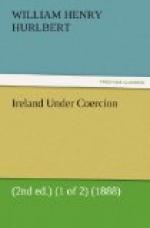Wednesday, Feb. 1.—This morning I called with Lord Ernest Hamilton upon Sir Bernard Burke, the Ulster King-at-Arms, and the editor or author of many other well-known publications, and especially of the “Peerage,” sometimes irreverently spoken of as the “British Bible.”
Sir Bernard’s offices are in the picturesque old “Bermingham” tower of the castle. There we found him wearing his years and his lore as lightly as a flower, and busy in an ancient chamber, converted by him into a most cosy modern study. He received us with the most cordial courtesy, and was good enough to conduct us personally through his domain.
Many of the State papers formerly kept here have been removed to the Four Courts building. But Sir Bernard’s tower is still filled with documents of the greatest historical interest, all admirably docketed and arranged on the system adopted at the Hotel Soubise, now the Palace of the Archives in Paris.
These documents, like the tower itself, take us back to the early days when Dublin was the stronghold of the Englishry in Ireland, and its citizens went in constant peril of an attack from the wild and “mere Irish” in the hills. The masonry of the tower is most interesting. The circular stone floors made up of slabs held together without cement, like the courses in the towers of Sillustani, by their exact adjustment, are particularly noteworthy. High up in the tower Sir Bernard showed us a most uncomfortable sort of cupboard fashioned in the huge wall of the tower, and with a loophole for a window. In this cell the Red Hugh O’Donnell of Tyrconnel was kept as a prisoner for several years under Elizabeth. He was young and lithe, however, and after his friends had tried in vain to buy him out, a happy thought one day struck him. He squeezed himself through the loophole, and, dropping unhurt to the ground, escaped to the mountains. There for a long time he made head against the English power. In 1597 he drove Sir Conyers Clifford from before the castle of Ballyshannon, with great loss to the English, and when he could no longer keep the field, he sought refuge in Spain. He was with the Spanish, as Prince of Tyrconnel, at the crushing defeat of Kinsale in 1601. Escaping again, he died, poisoned, at Simancas the next year.




